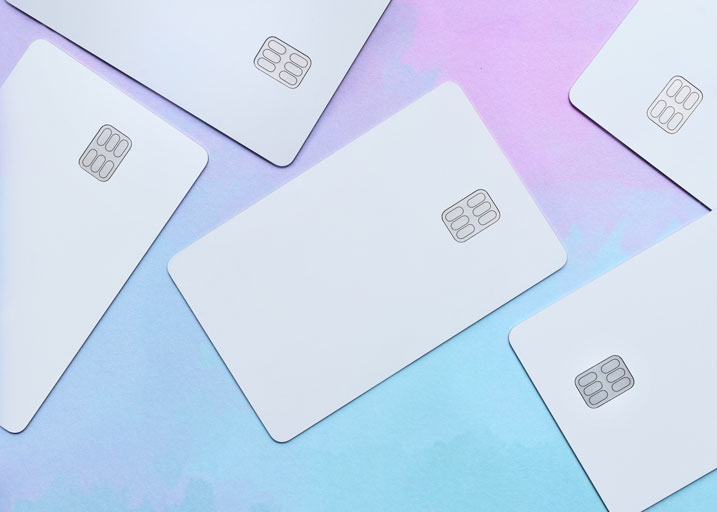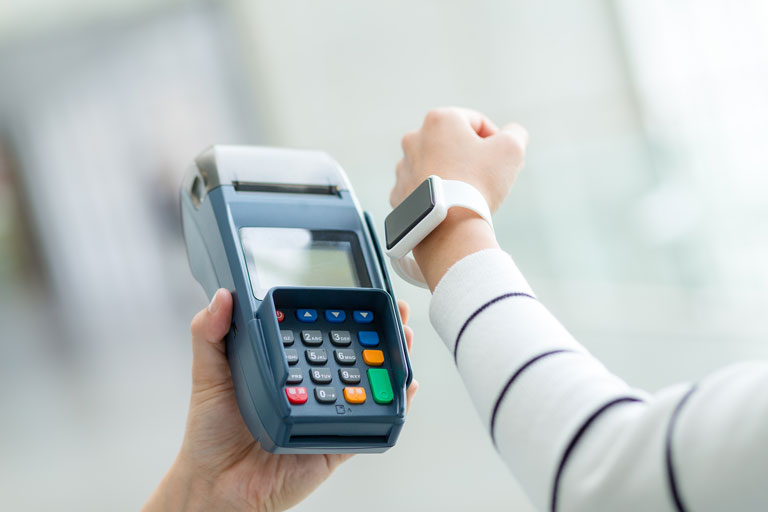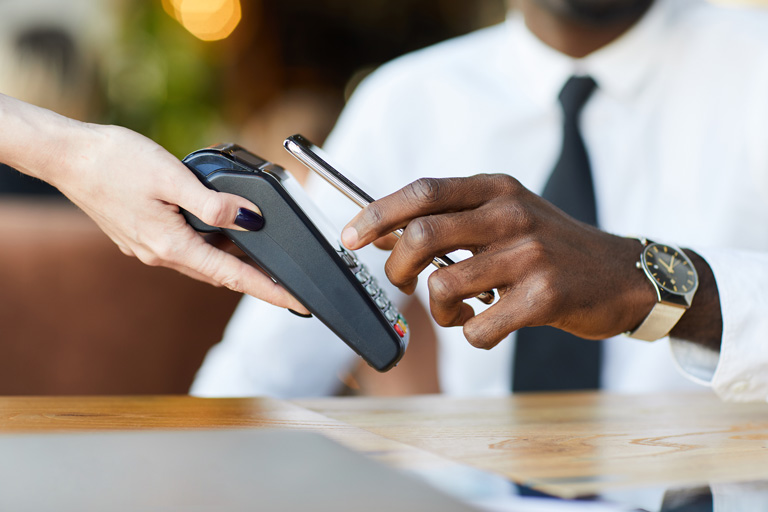Today NFC payments have become all the rage. But how did we get here? What the heck are they? Once upon a time, people used actual gold and silver coinage to negotiate the exchange of goods and services. Then in the 17th century, Europeans started to use debt notes in the form of paper currency (something they had already been doing in China for hundreds of years). And then, in the 20th century, they began to use plastic cards—credit and eventually debit cards—to make payments.
These plastic forms of payment have themselves undergone a number of transformations over the years…from raised numbers that could be used to take an imprint, to magnetic strips that could be swiped, to chips that could be inserted, to cards that could be tapped.
Each innovative step in credit card technology was meant to make the point of sale more secure and more convenient. The latest development in payment processing has seen the plastic credit card disappear entirely, as mobile wallets are used to facilitate cardless and contactless payments. And in some cases, cards embedded with an NFC chip are used to tap or hover the card over the POS terminal and complete the payment.
All of this is made possible with NFC technology.
What is NFC Technology?
Near Field Communication of NFC is a type of technology that allows two devices to communicate with each other when brought into close proximity. For consumers, that means holding a smartphone to a POS terminal to complete a payment or a card embedded with an NFC tag (also called an NFC chip).
NFC transactions that turn your smartphone into a payment device are somewhat new, but the technology itself has been around for a few decades. NFC payment technology (and NFC technology in general) actually evolved out of a similar technology called Radio Frequency Identification or RFID.
The first patent for RFID technology was issued in 1983 to Charles Walton, who had left IBM in the 1970s to start his own company—fittingly named Proximity Devices. The first of his creations was a (get ready to hold your breath) portable radio frequency emitting identifier that used an electrical current from a radio transceiver to activate a key card when the two devices were placed six inches from each other. In layman’s terms, an electronic door key, which he put into production with the Schlage Lock Company.
Walton was not the first to develop RFID technology, even though he was awarded ten patents for it. Other RFID products were already in existence, including systems used for sorting items like luggage and mail. But Walton significantly put this technology on the path toward widespread commercial dissemination.
Another one of his inventions was a system for handling automated toll collection—so next time you’re on a turnpike or freeway that uses this technology, take a moment to realize this is the precursor of mobile payments. And then shake your fist at that darned Department of Transportation for all those potholes (speaking to East Coast commuters here more than anyone, perhaps).
Are Barcodes the Same as NFC Technology?
You might be wondering if barcodes relate to RFID technology. While the concepts are similar, a barcode scanner requires a line of sight to the barcode it’s scanning, while an RFID reader does not require a sightline to the tag it’s reading.
And while both barcodes and RFID can be used to easily track objects, RFID offers some advantages in terms of speed, accuracy, and functionality—in addition to the fact that readers don’t need to see the barcode. They can read multiple RFID tags at one time.
Lastly, a barcode is not a device. It’s just a series of lines. NFC technology, by contrast, requires two devices—even if one of those devices is just a chip implanted inside of a card or a phone. That’s because the electromagnetic energy sent out by powered devices activates the passive chip or tag into vibrating out its information from tiny coils. Nothing of the sort happens with barcodes (or QR codes, which will be touched on later).
In any case, NFC tags and readers were the next links in the chain of radio wave development. In the early 2000s, companies like Philips, Sony, and Nokia started manufacturing devices with NFC chip technology. These devices used a particular RFID frequency of 13.56MHz to facilitate close-range communication. One of the first adoptions of this technology was to facilitate payments for public transportation systems.
So What are Contactless NFC Payments?
NFC mobile payments use NFC technology to turn your phone into a payment device. To understand how that works, let’s continue to look at how NFC works.
Active NFC Vs Passive NFC
NFC devices can operate in an active or passive mode. In the active mode, both devices are generating an electromagnetic field to exchange data. In passive mode, there is only one active device, while the other is just sending information. Active NFC requires both devices to have power, while passive NFC does not.
Passive NFC is the technology that could be used for an ID card one would tap to access something otherwise closed to the general public—for instance, a nurse opening a hospital door or a bank employee accessing a vault. And in terms of contactless payments, passive NFC is the technology that allows you to tap a credit card over a payment terminal. Because your credit card is not a powered device, although it may look sharp.
NFC Payment Operating Modes
Beyond the two modes of communication—active and passive—there are three operating modes: read/write, peer-to-peer, and card emulation. Read/write is a one-way exchange of information, while peer-to-peer allows two active devices to send information to each other. And card emulation allows an active device to function like a passive one. Which is often the principle behind using NFC to pay from some smartphone models. In other words, your phone turns itself into somewhat of an NFC-chip-embedded credit card behind the scenes.
So to review and summarize, NFC technology uses short-length radio waves to either pass information back and forth (in the case of two powered devices) or collect information one way, like from a chip-embedded card to the POS terminal. It can also, through card emulation, be used to turn an active device (like an operating smartphone) into a passive device by activating the NFC chip embedded in the phone itself.
Is NFC Technology the Same as Bluetooth or Wireless Technology?
NFC is not the same as Bluetooth or wireless technology. Bluetooth allows devices to communicate with one another at a greater range, in some cases up to 100 feet. Bluetooth also requires devices to be paired up through the voluntary selection of the operator. By contrast, NFC happens immediately, and in the case of passive mode, one of the devices does not even have to be powered (something that is not the case with Bluetooth).
And Wi-Fi technology specifically refers to allowing devices to connect to the internet. NFC enables communication between devices at a very short range, and it does not need internet connectivity to facilitate the exchange of card information.
This is an important consideration for merchants who are vendors at a fair, for instance, or even a brick-and-mortar location without internet (although that would be rare). This gives NFC payments an advantage over QR codes, which require an internet connection because they guide the customer to a website or cloud-based application to complete their payment.

Are NFC Payments Secure?
NFC payments are more secure than other forms of credit card payment technology like magnetic strips and even chips. One reason is that the data stored on a magnetic strip is static, which leaves it susceptible to something like a card skimmer—a tiny device attached to a POS system without the approval of the small business (or large business) collecting payments.
This device is used to collect information off the magnetic strip, which can then be used to make fraudulent payments and switch stolen card information.
Apple Pay Security Features
No such thing can occur with an NFC payment, because the data is not static: it’s dynamic and encrypted, or in other words, constantly changing. Take, for example, the technology used by Apple Pay to facilitate transactions, which uses tokenization to guard your banking details.
First, users upload their card information into their Apple Wallet. Apple then sends this information to the card issuer, which replaces the card information with a random alphanumeric series of numbers—also known as a token. This number is then programmed by Apple into your phone. Preventing the account details from being cloned by hackers or anyone who were to get their hands on your device or stored information.
To summarize, your card details are scrambled into something unintelligible and randomly generated, every time you place the phone near an NFC payment terminal to make your payment. This makes the data nearly impossible for potential fraudsters to extract…something they could do with the static data on a magnetic strip.
Touch ID and Facial Recognition Security
But wait…there’s more. Mobile wallets are protected by artificial intelligence security features. Some Apple Wallets are protected by Touch ID. Which means you have to unlock your phone with a fingerprint. More recent iPhones are secured with facial recognition, which means only your face has access to opening your mobile wallet. This means that even beyond the security offered by the tokenization process, there is a strong layer of security afforded by the authentication requirement.
Proximity Features
As mentioned, NFC is a subset of RFID technology, but the nature of NFC interactions and the type of radio wave frequency they use mean that the devices must be brought into close proximity to one another—6 inches, or in some cases, less than 4 inches. This prevents, for instance, someone walking around a store from collecting the credit card information of everyone in range.
Remember that unlike barcodes (or QR codes), RFID technology can scan multiple devices at once, even if they’re not in the line of sight, often within 100 meters. Using NFC technology specifically to facilitate payments circumnavigates the issue of a criminal entering, say a large department store, and making off with tons of credit card information—although that would certainly be a dramatic heist…silent, but deadly.
Data Protection
In terms of how data is protected, phones using the card emulation modality can either use cloud-based HCE or Host Card Emulation, or Secure Element (SE) which is device-based. Each type has its advantages or disadvantages. For instance, HCE means the phone itself is more secure (since it doesn’t really store any relevant information) but if the cloud server gets hacked, everyone will be compromised.
By contrast, there is no danger of that with SE, but if the phone itself gets lost, the customer has essentially lost their credit card—hence the reason why some companies add the biometric layer of security with fingerprint authorization.

What is EMV Payment?
EMV stands for Europay, Mastercard, and Visa, and the technology has to do with the chip in your credit card. These EMV chips are more secure than magnetic strips, so many credit card companies and banks are now issuing cards with chips in them. EMV cards were actually being used in Europe as early as 1986 but didn’t catch on in the United States until about 2010.
To give some additional insight into this payment landscape difference, note that in 2020 around 73% of card transactions in the U.S. were with a chip, while in Europe that percentage was just one point shy of 100. The chip itself is actually like a tiny computer that can communicate with the POS terminal to authenticate the cardholder. Making this form of payment more secure and the reason why European countries chose to adopt it over the magnetic strip.
EMV Payment Advantages
Implementing EMV technology terminals and card acceptance has not only become a card processing standard, but it also offers numerous benefits that merchants can appreciate in its adoption.
The major card brands such as Visa, Discover, MasterCard, and American Express continue to pressure the merchants in the American and even global markets to switch over from accepting traditional magnetic stripe cards to more advanced EMV chip cards.
Even though magstripe cards had been the card payment standard in the U.S. for decades, payments in the U.S. will be revolutionized by EMV technology as it offers new benefits for consumers, merchants, and processors alike.
EMV Technology Offers Advanced Transaction Security
One of the biggest reasons for the EMV technology push on cardholders and merchants alike is due to the advancement in security features that it offers for the payment process. For its predecessor, the magstripe card, all payment and personal information was stored right in the magstripe. Which made it easy for skimmers, hackers, and fraudsters to steal information and use it for unauthorized transactions or to create fake cards.
Conversely, EMV cards use a microprocessor smart chip to store all pertinent payment information. The chip also encrypts the data for security. With encryptions and microprocessor chips, fraudulent transactions have diminished. Criminals are able to access payment information through encryption and advanced technology would be required to duplicate the chip on an EMV card.
In addition, EMV cards offer numerous options for cardholders to verify their identity. All these factors play a huge role in increasing security, minimizing fraud, and protecting cardholders, merchants, banks, and payment processors.
EMV Technology Supports Contact Transactions, But Also, Contactless and Mobile Transactions Too
EMV chip technology typically is known for inserting the card’s chip into a payment terminal. This contact type of payment is where it started. However, Most EMV cards today are enabled with microchips inside the plastic to support contactless or tapped transactions as well, at participating terminals.
Contact “Dipped” Payments
Contact payments or “dipped” transactions require the card to remain in the terminal until the authorization and transaction have been completed. This payment type can take longer than a few seconds and sometimes makes it seem like we’re going back in time as far as advancements in efficiency are concerned.
Contactless “Tapped” Payments
However, contactless or “tapped” EMV transactions take a fraction of the time. In as little as 1 second or less, a contactless or NFC-enabled terminal will read the tapped chip and all its data. Completing a transaction as soon as you wave your card. Because of the efficiency it offers, contactless EMV payments are becoming more and more popular.
Mobile Payments
Finally, EMV technology can also be utilized by entering EMV card information into a smartphone’s mobile wallet app. From here, the same quick process occurs by waving a smartphone (with its mobile wallet open) over a contactless card reader and a secure transaction is completed in milliseconds.
Because of EMV technology’s wide variety of payment options, investing in a singular payment terminal that supports any and all the above EMV capabilities is the economical way to go that will open multiple avenues for customer point-of-sale.
EMV Technology Has Become a Global Standard
EMV technology originated in Europe and has made its way over to the United States. Because of that, it has become a global standard. Meaning, cardholders will soon only have EMV-enabled cards. Especially with its seamless international transaction capabilities. This is beneficial for both American cardholders and domestic merchants.
Meaning, American travelers will have no conflict when attempting to make a transaction at an international merchant. And domestic merchants in the US will be able to accept purchases from international travelers and tourists with EMV cards.
EMV Payment Disadvantages
However, the downside is that EMV payments take a little bit longer to process. In fact, paying with a chip can take up to 15 seconds. NFC is the fastest way to pay, faster than both magnetic strips and EMV chips. American Express even claims that contactless transitions are 63% faster than cash and 53% faster than traditional credit card swiping or inserting.
While the difference of a few seconds may not seem like such a big deal, in a busy retail setting it can make a significant difference. Consider that four customers paying with an EMV chip could take up to one minute total just to process their card (not including all other parts of the checkout experience) and that 12 contactless NFC payments could be made in the same time if they all took 5 seconds or less.
Numbers like this, although just an example, show a scenario where NFC payments can speed up the processing time by threefold (12 instead of 4), which can greatly improve customer experience.
NFC Payment Vs EMV Payment
Part of this consideration is the fact that in some cases, NFC payments do not require the input of a PIN. In terms of discussing security concerns, that does raise an issue with contactless cards.
But cards stored on mobile wallets on locked smartphone devices—especially ones that require biometric authentication—may require pins. Even without that layer, the fingerprint requirement makes them impossible for criminals to steal and use.
All the same, EMV payments are still fairly standard. Not all customers are making payments with their mobile devices. Although some estimates have put that number at 71% in the U.S. This means that a decent number of consumers are still using plastic cards to pay. And not all of these cards are equipped with contactless technology either.
Even for those that are, consumers may still (without thinking) default to methods of payment like inserting a chip or swiping their card when possible. That said, merchants should not have exclusively NFC terminals, but POS terminals that can process NFC payments, chip payments, and yes—good old-fashioned swiping for cards with chips that aren’t working.

Are Wearables the Future of NFC Payments?
As mentioned at the outset of our article, fintech is always evolving, and that evolution has particularly accelerated within the past half-century, lately culminating in NFC payment devices.
The Apple Watch
One interesting development in smartphone technology (and therefore in mobile contactless payments) are wearables like the Apple Watch. These devices can also facilitate retail NFC payment, by a consumer waving or holding their watch near the POS terminal.
Apple watches offer several other functionalities in terms of health monitoring and social interaction, for example. The convenience driven by their variegated usage is probably why 30% of iPhone owners are already wearing them.
And that means an increasing number of consumers are probably going to be making contactless payments with just their watches—somewhat of an ironic comeback for a piece of technology that was supplanted by the smartphone.
But that’s not the end of the story. Consumers want to ditch their billfolds. A poll of Gen Zers found that 77% of them wanted to just make mobile payments. And maybe someday, they’ll want to ditch their smartphones too…sort of.

Microchips
People are using smartphones for everything these days, but really it’s the applications they want and not necessarily the device itself. That’s leading some technology experts, entrepreneurs, and mad scientists (according to some) to develop the integration of biology and technology—embedded devices in the human body.
Although it may sound dystopian and perhaps zombie-like to imagine everyone scrolling through Facebook as they stare into space, leaving aside the ethics and just focusing on how NFC payment works, there have been interesting developments.
Already as of 2019 select adventurous Europeans paid for surgeries to install microchips in their hand, which they can wave in front of the POS terminal to complete their payment. Although microchipping dogs for safety purposes has been common practice for a while, the adoption of NFC tags under your skin is new territory.
To contact sales, click HERE. And to learn more about ECS NFC Payments visit Contactless.
